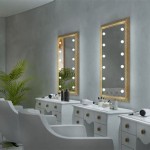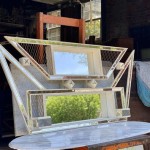How to Paint a Mirror Frame Antique White
Painting a mirror frame antique white is a relatively simple project that can dramatically update the look of a room. This process involves more than just applying a coat of white paint; it requires careful surface preparation, strategic application, and antiquing techniques to achieve the desired aged aesthetic. This article provides a comprehensive guide on how to transform a mirror frame into a beautiful, antique white accent piece.
Gathering Necessary Materials and Tools
Before commencing the project, it is essential to gather all the necessary materials and tools. This will ensure a smooth and efficient process, minimizing interruptions and maximizing the quality of the finished product. Proper preparation is key to achieving a professional-looking result.
First, the choice of paint is crucial. Opt for a high-quality latex or acrylic paint in an antique white shade. Semi-gloss or satin finishes are preferable as they offer durability and ease of cleaning. Chalk paint is another viable option, particularly if a heavily distressed look is desired. The size of the mirror frame will dictate the quantity of paint required; generally, a quart should be sufficient for most standard-sized frames. Primer is likewise necessary—choose a primer suitable for the frame's material (wood, metal, or plastic). A bonding primer is recommended for slick or glossy surfaces, as it promotes better paint adhesion.
The tools required include: sandpaper (various grits, such as 120, 220, and 320), a sanding block or orbital sander, painter's tape, drop cloths or newspapers, cleaning supplies (such as a tack cloth or damp rag), paintbrushes (both small and medium sizes), foam rollers (optional, for a smoother finish), paint trays or palettes, antiquing glaze or wax, clean rags or cheesecloth, and protective gear (gloves and a dust mask or respirator). A scraper or putty knife may also be needed for removing old paint or imperfections.
The work area should be well-ventilated and protected from dust and debris. Lay down drop cloths or newspapers to protect the surrounding surfaces from paint splatters. Proper lighting is also essential for ensuring even coverage and identifying any missed spots or imperfections during the painting process.
Preparing the Mirror Frame for Painting
Proper surface preparation is paramount for achieving a professional and durable finish. This stage involves cleaning, sanding, and priming the mirror frame, ensuring that the paint adheres properly and the final result is aesthetically pleasing. Skipping this step can lead to peeling paint, uneven coverage, and a generally unsatisfactory outcome.
The initial step involves cleaning the mirror frame thoroughly. Use a damp rag with mild soap and water to remove any dirt, dust, grease, or other contaminants. Pay particular attention to corners and crevices where debris may accumulate. Allow the frame to dry completely before proceeding to the next step. For stubborn grime, a degreasing cleaner may be necessary.
Next, sanding the frame is crucial for creating a textured surface that promotes paint adhesion. Begin with a coarser grit sandpaper (e.g., 120 grit) to remove any existing paint, varnish, or imperfections. Focus on areas with chipped paint or rough spots. Once the surface is reasonably smooth, switch to a medium-grit sandpaper (e.g., 220 grit) to further refine the surface. Finally, use a fine-grit sandpaper (e.g., 320 grit) to create a smooth, even finish. Sand in the direction of the wood grain whenever possible. For intricate details or hard-to-reach areas, use a sanding block or smaller pieces of sandpaper. After sanding, thoroughly remove all sanding dust with a tack cloth or damp rag.
Protect the mirror surface itself by carefully applying painter's tape around the edges of the frame. Ensure that the tape is firmly pressed down to prevent paint from seeping underneath. For extra protection, consider covering the entire mirror surface with paper or plastic sheeting.
The final step in surface preparation is applying a primer. Choose a primer that is suitable for the material of the frame (wood, metal, or plastic). Apply a thin, even coat of primer using a paintbrush or foam roller. Ensure that all surfaces are covered, paying attention to corners and crevices. Allow the primer to dry completely according to the manufacturer's instructions. Once the primer is dry, lightly sand the surface with fine-grit sandpaper to remove any imperfections and create an even smoother surface for the paint. Remove all sanding dust before proceeding to the painting stage.
Painting and Antiquing the Mirror Frame
Applying the antique white paint and implementing antiquing techniques are the core steps in transforming the mirror frame. This involves carefully applying multiple coats of paint and strategically using antiquing glazes or waxes to create the desired aged appearance. Patience and attention to detail are critical for achieving a professional and authentic-looking finish.
Begin by applying the first coat of antique white paint. Use a paintbrush or foam roller, depending on the desired finish. Apply the paint in thin, even strokes, working in the direction of the wood grain whenever possible. Avoid applying too much paint at once, as this can lead to drips and uneven coverage. Pay attention to corners and crevices, ensuring that all surfaces are coated. Allow the first coat of paint to dry completely according to the manufacturer's instructions. Once the first coat is dry, lightly sand the surface with fine-grit sandpaper to remove any imperfections and create a smoother surface for the second coat.
Apply a second coat of antique white paint, following the same techniques as with the first coat. This coat will provide more complete coverage and enhance the color and finish. Allow the second coat to dry completely. Depending on the desired level of coverage and opacity, a third coat may be necessary. If applying a third coat, allow each coat to dry completely before proceeding.
Once the final coat of paint is dry, it is time to apply the antiquing glaze or wax. There are several ways to achieve an antique look. One method involves using an antiquing glaze, which is a translucent coating that adds depth and dimension to the finish. Apply a small amount of glaze to a clean rag or cheesecloth and gently wipe it onto the painted surface. Work in small sections, focusing on areas where age and wear would naturally occur, such as corners, edges, and crevices. Immediately wipe away the excess glaze with a clean rag, leaving a subtle tint in the recesses and details. Adjust the amount of glaze to achieve the desired level of antiquing.
Another method involves using antiquing wax, which is a solid wax that adds a similar effect. Apply a small amount of wax to a clean rag or brush and gently rub it onto the painted surface. Again, focus on areas where age and wear would naturally occur. Allow the wax to sit for a few minutes, then buff it with a clean rag to create a soft, subtle sheen. The amount of wax and buffing can be adjusted to achieve the desired level of antiquing.
For a more distressed look, consider using sandpaper to lightly remove some of the paint in strategic areas, such as edges and corners. This will reveal the underlying layers of paint or the bare material, creating a worn and aged appearance. Be careful not to over-sand, as this can damage the frame. Experiment with different techniques and materials to achieve the desired aesthetic.
Once the antiquing process is complete, allow the glaze or wax to dry and cure completely according to the manufacturer's instructions. This will ensure that the finish is durable and long-lasting. Finally, carefully remove the painter's tape from the edges of the mirror, revealing the clean, antique white frame. Inspect the frame for any imperfections or missed spots and make any necessary touch-ups.

How To Paint A Mirror Frame Antique White Well Purposed Woman

How To Paint A Mirror Frame Antique White Well Purposed Woman

Chalk Paint And Antiquing A Frame Mirror Diy Painting Frames

12 Techniques To Painting Antique Mirrors Hallstrom Home

Chalk Painting An Antique Mirror Frame Tutorial Rise And Renovate

How To Paint A Mirror Frame Antique White Müller Designs

How To Paint A Mirror Frame Antique White Well Purposed Woman

Chalk Painting And Antiquing A Frame Antique Mirror Diy Frames

How To Paint A Mirror Frame Antique White Müller Designs

How To Paint A Mirror Frame Antique White Well Purposed Woman








